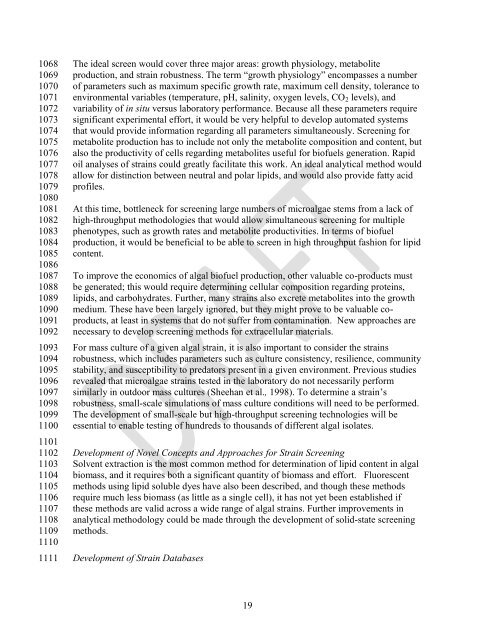Download the Algal Biofuels Roadmap draft document - Sandia
Download the Algal Biofuels Roadmap draft document - Sandia
Download the Algal Biofuels Roadmap draft document - Sandia
You also want an ePaper? Increase the reach of your titles
YUMPU automatically turns print PDFs into web optimized ePapers that Google loves.
1068<br />
1069<br />
1070<br />
1071<br />
1072<br />
1073<br />
1074<br />
1075<br />
1076<br />
1077<br />
1078<br />
1079<br />
1080<br />
1081<br />
1082<br />
1083<br />
1084<br />
1085<br />
1086<br />
1087<br />
1088<br />
1089<br />
1090<br />
1091<br />
1092<br />
1093<br />
1094<br />
1095<br />
1096<br />
1097<br />
1098<br />
1099<br />
1100<br />
1101<br />
1102<br />
1103<br />
1104<br />
1105<br />
1106<br />
1107<br />
1108<br />
1109<br />
1110<br />
1111<br />
The ideal screen would cover three major areas: growth physiology, metabolite<br />
production, and strain robustness. The term ―growth physiology‖ encompasses a number<br />
of parameters such as maximum specific growth rate, maximum cell density, tolerance to<br />
environmental variables (temperature, pH, salinity, oxygen levels, CO2 levels), and<br />
variability of in situ versus laboratory performance. Because all <strong>the</strong>se parameters require<br />
significant experimental effort, it would be very helpful to develop automated systems<br />
that would provide information regarding all parameters simultaneously. Screening for<br />
metabolite production has to include not only <strong>the</strong> metabolite composition and content, but<br />
also <strong>the</strong> productivity of cells regarding metabolites useful for biofuels generation. Rapid<br />
oil analyses of strains could greatly facilitate this work. An ideal analytical method would<br />
allow for distinction between neutral and polar lipids, and would also provide fatty acid<br />
profiles.<br />
At this time, bottleneck for screening large numbers of microalgae stems from a lack of<br />
high-throughput methodologies that would allow simultaneous screening for multiple<br />
phenotypes, such as growth rates and metabolite productivities. In terms of biofuel<br />
production, it would be beneficial to be able to screen in high throughput fashion for lipid<br />
content.<br />
To improve <strong>the</strong> economics of algal biofuel production, o<strong>the</strong>r valuable co-products must<br />
be generated; this would require determining cellular composition regarding proteins,<br />
lipids, and carbohydrates. Fur<strong>the</strong>r, many strains also excrete metabolites into <strong>the</strong> growth<br />
medium. These have been largely ignored, but <strong>the</strong>y might prove to be valuable coproducts,<br />
at least in systems that do not suffer from contamination. New approaches are<br />
necessary to develop screening methods for extracellular materials.<br />
For mass culture of a given algal strain, it is also important to consider <strong>the</strong> strains<br />
robustness, which includes parameters such as culture consistency, resilience, community<br />
stability, and susceptibility to predators present in a given environment. Previous studies<br />
revealed that microalgae strains tested in <strong>the</strong> laboratory do not necessarily perform<br />
similarly in outdoor mass cultures (Sheehan et al., 1998). To determine a strain‘s<br />
robustness, small-scale simulations of mass culture conditions will need to be performed.<br />
The development of small-scale but high-throughput screening technologies will be<br />
essential to enable testing of hundreds to thousands of different algal isolates.<br />
Development of Novel Concepts and Approaches for Strain Screening<br />
Solvent extraction is <strong>the</strong> most common method for determination of lipid content in algal<br />
biomass, and it requires both a significant quantity of biomass and effort. Fluorescent<br />
methods using lipid soluble dyes have also been described, and though <strong>the</strong>se methods<br />
require much less biomass (as little as a single cell), it has not yet been established if<br />
<strong>the</strong>se methods are valid across a wide range of algal strains. Fur<strong>the</strong>r improvements in<br />
analytical methodology could be made through <strong>the</strong> development of solid-state screening<br />
methods.<br />
Development of Strain Databases<br />
19


